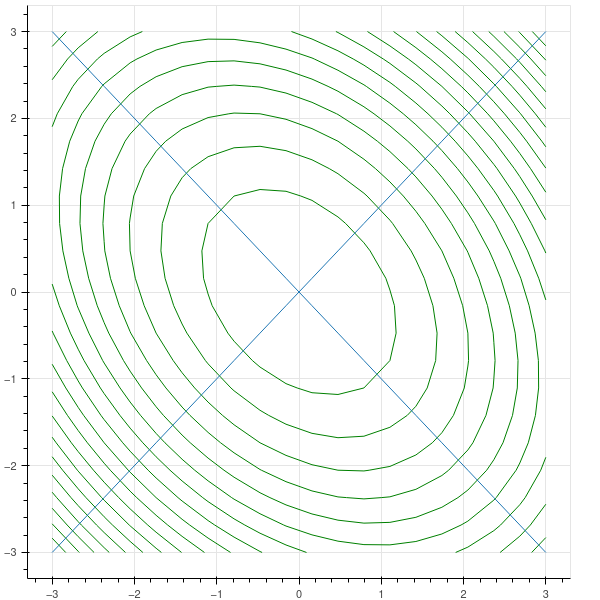Proof of the real spectral theorem
Orthogonal bases and Gram-Schmidt
Proposition: (The Gram-Schmidt process) Let $V$ be a real inner product space of dimension $n$, and let $v_1,\ldots, v_k$ be a linearly independent set in $V$. Then there is a set $w_1,\ldots, w_k$ of vectors such that
- $\langle w_i, w_j\rangle=0$ if $i\not=j$.
- the span of $w_1, \ldots, w_l$ is the same as the span of $v_1,\ldots, v_l$ for $l\le k$.
Proof: Let $w_1=v_1$ and \(w_2 = v_2-\frac{\langle v_2, w_1\rangle}{\norm{w_1}^2}w_1.\) Then the span of $w_2$ and $w_1$ is the same as that of $v_2$ and $v_1$, and $\langle w_2, w_1\rangle=0$ by construction. Now suppose we have constructed $w_1,\ldots, w_l$ with the desired property. Set
\[w_{l+1} = v_{l+1}-\sum_{i=1}^{l} \frac{\langle v_{l+1}, w_{i}\rangle}{\norm{w_{i}}^2}w_{i}.\]Then $\langle w_{l+1}, w_{i}\rangle=0$ and the span property is preserved.
Orthogonal complements
If $W$ is a subspace of $V$, define $W^{\perp}=\lbrace v : \langle v,w\rangle=0\rbrace$.
Proposition: $W^{\perp}$ is a subspace of $V$. Furthermore:
- $\dim W+\dim W^{\perp}=\dim V$ (so $W\cap W^{\perp}=0$.)
- $(W^{\perp})^{\perp}=W$.
- if $U\subset W$, then $W^{\perp}\subset U^{\perp}$.
Proof: Suppose $\dim W=k$ and $\dim V=n$. Use Gram-Schmidt to construct an orthogonal basis $v_1,\ldots, v_n$ for $V$ whose first $k$ elements are an orthogonal basis for $W$. A vector
\[v=\sum a_{i}v_{i}\]is in $W^{\perp}$ if and only if $a_i=0$ for $i=1,\ldots, k$.
Proposition: Suppose that $A$ is a self adjoint operator and $AW\subset W$. Then $AW^{\perp}\subset W^{\perp}$.
Proof: Suppose $z\in W^{\perp}$ and $w\in W$. Then
\[\langle Az,w\rangle = \langle z, A^{\ast}w\rangle=\langle z, Aw\rangle = 0\]since $Aw\in W$.
Proof of the (real) spectral theorem
We have a self-adjoint map $A:V\to V$. Pick a basis for $V$ and use Gram-Schmidt to construct an orthonormal basis (an orthogonal basis where the elements all have norm $1$).
The $Q$-matrix for this basis is the identity, and so the inner product is just the dot product.
If $[A]$ is the matrix representation of $A$ in this basis, then the matrix representation of $A^{\ast}$ is the transpose of $[A]$. So since $A$ is self-adjoint, $[A]$ is symmetric.
We know that a symmetric matrix has a real eigenvalue $\lambda_1$ with eigenvector $v_1$.
Let $V_1$ be the orthogonal complement to the one-dimensional space $W$ spanned by $v_1$. Since $v_1$ is an eigenvector, $AW\subset W$. Therefore $AV_1\subset V_1$. Furthermore, if $x,y\in V_1$, then
\[\langle Ax, y\rangle=\langle x, Ay\rangle\]so $A$ is self-adjoint as a linear map from $V_1$ to itself. Thus we can continue by induction to construct an orthogonal basis of eigenvectors for $A$.
Orthogonal matrices
Let $Q\in M_{n}(\R)$ be a symmetric matrix. As such it is a self adjoint map from $\R^{n}$ to itself with respect to the usual dot product. Therefore there is a basis $v_1,\ldots, v_n$ of $\R^{n}$ consisting of orthonormal eigenvectors for the dot product $Q$- eigenvalues $\lambda_1,\ldots, \lambda_n$.
Let $P$ be the matrix whose columns are the vectors $v_{i}$ written in the standard basis of $\R^{n}$. Since the $v_{i}$ are an orthonormal basis, the matrix $P$ satisfies $P^{T}P=I$.
At the same time,
\[QP=P\Lambda\]where $\Lambda$ is the diagonal matrix with entries $\lambda_{i}$. Since the $v_{i}$ are linearly independent, the matrix $P$ is invertible and $Q$ is diagonalizable:
\[P^{-1}QP=\Lambda\]The bilinear map $\langle v,w\rangle$ defined by
\[\langle v,w\rangle= v^{T}Qw\]is an inner product provided that $\langle v,v\rangle\ge 0$ with equality only one $v=0$. If we write $v\not=0$ in terms of the orthogonal basis $v_1,\ldots, v_n$:
\[v=\sum a_{i}v_{i}\]then we get
\[\langle v,v\rangle=(\sum a_{i}v_{i}^{T})Q(\sum a_{i}v_{i})=\sum a_{i}v_{i}^{T}\lambda_{i}v_{i}=\sum a_{i}^2\lambda_{i}v_{i}^{T}v_{i}\]which will be positive provided that all $\lambda_{i}>0$.
Example
Let $Q$ be the symmetric matrix
\[Q=\left(\begin{matrix} 3 & 1\\1 & 3\end{matrix}\right)\]Its eigenvalues are $2$ and $4$ with eigenvectors
\[\left[\begin{matrix} -\sqrt{2} \\ \sqrt{2}\end{matrix}\right]\]and
\[\left[\begin{matrix} 2\sqrt{2} \\ 2\sqrt{2}\end{matrix}\right].\]The norm of a vector in the inner product given by $Q$ is
\[\norm{(x,y)}=3x^2+2xy+3y^2\]The level curves of this are ellipses, and the eigenvectors point in the directions of the major and minor axes of the ellipse.

These ellipses are the family
\[2(x-y)^2+4(x+y)^2=C\]